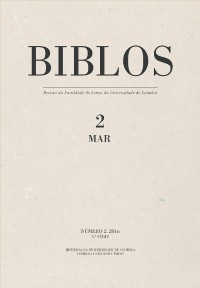Please use this identifier to cite or link to this item:
https://hdl.handle.net/10316.2/39169| Title: | Il mare degli antichi e i suoi pericoli. Tra gorghi, stretti e rupi cozzanti | Other Titles: | Eddies, straits and clashing rocks: the dangerous sea of Ancient Greeks | Authors: | Angelini, Anna | Keywords: | Mare;Stretti;Rupi cozzanti;Geografia simbolica;Mito;Sea;Strait;Clashing rocks;Symbolic Geography;Myth | Issue Date: | 2016 | Publisher: | Imprensa da Universidade de Coimbra | Abstract: | The representation of the sea in antiquity is characterized by a great ambiguity. The sea mirrors the earthly space in an upside-down way, and its surface represents a separation between what is known or knowledgeable (on the water) and what is obscure and unknown (under the water). For that reason, sentering the sea can be compared, in some cases, to travelling in the netherworld. This paper investigates the symbolic geography of sea and seafaring, focusing on the mythology of straits and on the myth of the clashing rocks in the Mediterranean Sea. These moving rocks that receive various names in ancient sources, open and close periodically, smashing every ship that tries to pass: they perfectly represent the precariousness of the passage and foster the image of the straits as a threshold between two worlds. Nell’immaginario degli antichi, la rappresentazione del mare è caratterizzata da una forte ambivalenza. Il suo spazio rappresenta un riflesso rovesciato del mondo terrestre e la sua superficie costituisce il limite tra una dimensione ben nota all’esperienza e un’altra che rimane oscura e indecifrabile. Come tale, la navigazione può essere metafora tanto di un’esperienza conoscitiva quanto di una prova mortale, dal momento che solcare lo spazio delle acque marine non è mai un’attività esente da rischi. Il presente contributo si focalizza sulla rappresentazione mitica dei pericoli della navigazione per mare nell’antichità e sulla loro geografia simbolica. Esso indaga in particolare l’organizzazione spaziale degli stretti. Una rilevante figurazione mitica dei pericoli dello stretto è costituita dalle cosiddette rupi erranti o “cozzanti”, variamente nominate dalle fonti antiche. Queste rocce mobili rappresentano a pieno l’instabilità del passaggio, e l’ambivalente statuto dello stretto come soglia. |
URI: | https://hdl.handle.net/10316.2/39169 | ISSN: | 0870-4112 2183-7139 (digital) |
DOI: | 10.14195/0870-4112_3-2_3 | Rights: | open access |
| Appears in Collections: | Biblos |
Files in This Item:
| File | Description | Size | Format | |
|---|---|---|---|---|
| il_mare_degli_antichi.pdf | 19.86 MB | Adobe PDF |  |
Items in DSpace are protected by copyright, with all rights reserved, unless otherwise indicated.
